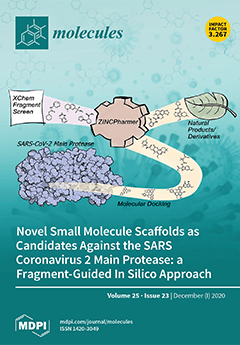The self-assembly of iron(III) chloride with three pyrazolyl-
s-triazine ligands, namely 2,4-bis(3,5-dimethyl-1
H-pyrazol-1-yl)-6-(piperidin-1-yl)-1,3,5-triazine (
PipBPT), 4-(4,6-bis(3,5-dimethyl-1
H-pyrazol-1-yl)-1,3,5-triazin-2-yl)morpholine (
MorphBPT), and 4,4’-(6-(3,5-dimethyl-1
H-pyrazol-1-yl)-1,3,5-triazine-2,4-diyl)dimorpholine (
bisMorphPT) afforded [Fe(
PipBPT)Cl
2][FeCl
4] (
[...] Read more.
The self-assembly of iron(III) chloride with three pyrazolyl-
s-triazine ligands, namely 2,4-bis(3,5-dimethyl-1
H-pyrazol-1-yl)-6-(piperidin-1-yl)-1,3,5-triazine (
PipBPT), 4-(4,6-bis(3,5-dimethyl-1
H-pyrazol-1-yl)-1,3,5-triazin-2-yl)morpholine (
MorphBPT), and 4,4’-(6-(3,5-dimethyl-1
H-pyrazol-1-yl)-1,3,5-triazine-2,4-diyl)dimorpholine (
bisMorphPT) afforded [Fe(
PipBPT)Cl
2][FeCl
4] (
1), [Fe(
MorphBPT)Cl
2][FeCl
4] (
2), and [H(
bisMorphPT)][FeCl
4].
bisMorphPT.2H
2O (
3), respectively, in good yield. In complexes
1 and
2, the Fe(III) is pentacoordinated with three Fe-N interactions from the pincer ligand and two coordinated chloride anions in the inner sphere, and FeCl
4¯ in the outer sphere. Complex
3 is comprised of one protonated ligand as cationic part, one FeCl
4¯ anion, and one neutral
bisMorphPT molecule in addition to two crystallized water molecules. Analysis of molecular packing using Hirshfeld calculations indicated that H…H and Cl…H are the most important in the molecular packing. They comprised 40.1% and 37.4%, respectively in
1 and 32.4% and 37.8%, respectively in
2. Complex
1 exhibited the most bioactivity against the tested microbes while
3 had the lowest bioactivity. The
bisMorphPT and
MorphBPT were inactive towards the tested microbes while
PipBPT was active. As a whole, the Fe(III) complexes have enhanced antibacterial and antifungal activities as compared to the free ligands.
Full article






